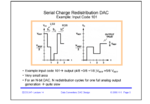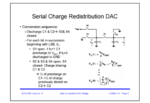AllenD
Member level 5
Hi Team
I have a question about DAC design.
1. So for a DAC, what is the input waveform should look like?
A) A true digital signal, eg, made of "011001" B) A quintized analog signal, eg, the output of a ADC?
2. I assume the answer to the 1st question is "A", then, let's say I have a DAC using R2R Binary Ladder, are the input of the DAC(V1-V4)
A) Arrive at the same time B) Arrive one by one in the time domain.
Thanks
Allen
I have a question about DAC design.
1. So for a DAC, what is the input waveform should look like?
A) A true digital signal, eg, made of "011001" B) A quintized analog signal, eg, the output of a ADC?
2. I assume the answer to the 1st question is "A", then, let's say I have a DAC using R2R Binary Ladder, are the input of the DAC(V1-V4)
A) Arrive at the same time B) Arrive one by one in the time domain.
Thanks
Allen

